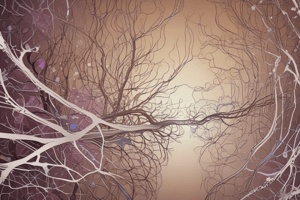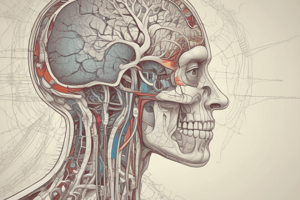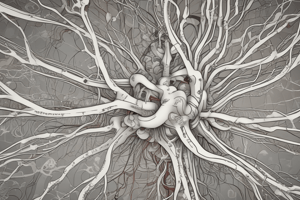Podcast
Questions and Answers
What is the primary function of sensory nerve fibers?
What is the primary function of sensory nerve fibers?
- They secrete neurotransmitters like acetylcholine.
- They carry motor impulses from the body to the central nervous system.
- They are responsible for the thickness of nerve fibers.
- They transmit sensory impulses to the central nervous system. (correct)
Which type of nerve fibers are known to secrete noradrenaline?
Which type of nerve fibers are known to secrete noradrenaline?
- Type C nerve fibers
- Type B nerve fibers
- Cholinergic nerve fibers
- Adrenergic nerve fibers (correct)
How are Type A nerve fibers classified?
How are Type A nerve fibers classified?
- By the diameter and conduction velocity (correct)
- Based on their neurotransmitter secretion
- By the site of synapse termination
- According to their myelination status
What is the conduction velocity of Type A gamma fibers?
What is the conduction velocity of Type A gamma fibers?
Which statement is true regarding Type C nerve fibers?
Which statement is true regarding Type C nerve fibers?
What is the primary function of attachment proteins such as V SNARE and T SNARE in synapse structure?
What is the primary function of attachment proteins such as V SNARE and T SNARE in synapse structure?
Which type of synapse is characterized by the direct passage of ions between neurons through gap junctions?
Which type of synapse is characterized by the direct passage of ions between neurons through gap junctions?
Which type of postsynaptic potential results from the binding of excitatory neurotransmitters and can lead to action potential generation?
Which type of postsynaptic potential results from the binding of excitatory neurotransmitters and can lead to action potential generation?
What is primarily removed from the synaptic cleft to terminate the action of neurotransmitters?
What is primarily removed from the synaptic cleft to terminate the action of neurotransmitters?
Which of the following accurately describes the composition of the extracellular fluid (ECF) in the synaptic cleft?
Which of the following accurately describes the composition of the extracellular fluid (ECF) in the synaptic cleft?
What is the primary responsibility of the somatic nervous system?
What is the primary responsibility of the somatic nervous system?
Which statement correctly distinguishes motor neurons from sensory neurons?
Which statement correctly distinguishes motor neurons from sensory neurons?
Which type of nerve fibers are considered myelinated?
Which type of nerve fibers are considered myelinated?
What distinguishes visceral nerve fibers from somatic nerve fibers?
What distinguishes visceral nerve fibers from somatic nerve fibers?
Which comparison correctly describes cranial nerve fibers versus spinal nerve fibers?
Which comparison correctly describes cranial nerve fibers versus spinal nerve fibers?
How do sensory neurons generally differ in structure from motor neurons?
How do sensory neurons generally differ in structure from motor neurons?
What feature is unique to neurons compared to other cells?
What feature is unique to neurons compared to other cells?
What classification criterion is used for nerve fibers that distinguishes them based on their origin?
What classification criterion is used for nerve fibers that distinguishes them based on their origin?
What are the two main parts of the nervous system?
What are the two main parts of the nervous system?
In which part of the brain is the white matter located?
In which part of the brain is the white matter located?
What does gray matter predominantly consist of?
What does gray matter predominantly consist of?
Which layer of the meninges is closest to the brain and spinal cord?
Which layer of the meninges is closest to the brain and spinal cord?
What is the role of cerebrospinal fluid?
What is the role of cerebrospinal fluid?
What type of neurons are primarily found in the peripheral nervous system?
What type of neurons are primarily found in the peripheral nervous system?
Which part of the nervous system is responsible for quicker responses compared to the endocrine system?
Which part of the nervous system is responsible for quicker responses compared to the endocrine system?
Which of the following correctly describes the arrangement of gray and white matter in the spinal cord?
Which of the following correctly describes the arrangement of gray and white matter in the spinal cord?
What is the effect of alkalosis on synaptic transmission?
What is the effect of alkalosis on synaptic transmission?
Which substance is known to inhibit the effect of GABA and can lead to severe excitatory responses?
Which substance is known to inhibit the effect of GABA and can lead to severe excitatory responses?
What role do small molecules play in the nervous system?
What role do small molecules play in the nervous system?
How does hypoglycemia affect synaptic transmission?
How does hypoglycemia affect synaptic transmission?
In which condition does prolonged hypoxia lead to brain damage?
In which condition does prolonged hypoxia lead to brain damage?
Which type of chemical transmitter is known for its prolonged action compared to small molecules?
Which type of chemical transmitter is known for its prolonged action compared to small molecules?
What is a significant effect of the neurotoxin produced by tetanus bacteria?
What is a significant effect of the neurotoxin produced by tetanus bacteria?
Which of the following diseases is associated with the blockage of acetylcholine release?
Which of the following diseases is associated with the blockage of acetylcholine release?
What is the primary effect of inhibitory postsynaptic potentials (IPSPs) on the postsynaptic membrane?
What is the primary effect of inhibitory postsynaptic potentials (IPSPs) on the postsynaptic membrane?
Which of the following describes the mechanism of presynaptic inhibition?
Which of the following describes the mechanism of presynaptic inhibition?
What causes synaptic fatigue during rapid repetitive stimulation?
What causes synaptic fatigue during rapid repetitive stimulation?
What characterizes the directionality of synaptic transmission?
What characterizes the directionality of synaptic transmission?
What is responsible for long-term potentiation in the hippocampus?
What is responsible for long-term potentiation in the hippocampus?
During short-term inhibition (habituation), what primarily causes the decreased response to stimuli?
During short-term inhibition (habituation), what primarily causes the decreased response to stimuli?
What effect does presynaptic facilitation have on neurotransmitter release?
What effect does presynaptic facilitation have on neurotransmitter release?
Which term describes the phenomenon where a benign stimulus loses its efficacy due to repeated exposure?
Which term describes the phenomenon where a benign stimulus loses its efficacy due to repeated exposure?
What is the primary function of synaptic plasticity?
What is the primary function of synaptic plasticity?
What is a key feature of synaptic delay?
What is a key feature of synaptic delay?
Flashcards
Central Nervous System (CNS)
Central Nervous System (CNS)
The part of the nervous system consisting of the brain and spinal cord.
Peripheral Nervous System (PNS)
Peripheral Nervous System (PNS)
The part of the nervous system that connects the CNS to the rest of the body.
Gray Matter
Gray Matter
Part of the brain and spinal cord composed of nerve cell bodies and the proximal parts of nerve fibers.
White Matter
White Matter
Signup and view all the flashcards
Meninges
Meninges
Signup and view all the flashcards
Cerebrospinal Fluid (CSF)
Cerebrospinal Fluid (CSF)
Signup and view all the flashcards
Cranial Nerves
Cranial Nerves
Signup and view all the flashcards
Spinal Nerves
Spinal Nerves
Signup and view all the flashcards
Sensory Nerve Fibers
Sensory Nerve Fibers
Signup and view all the flashcards
Motor Nerve Fibers
Motor Nerve Fibers
Signup and view all the flashcards
Adrenergic Nerve Fibers
Adrenergic Nerve Fibers
Signup and view all the flashcards
Type A Nerve Fibers
Type A Nerve Fibers
Signup and view all the flashcards
Synapse
Synapse
Signup and view all the flashcards
Somatic Nervous System
Somatic Nervous System
Signup and view all the flashcards
Autonomic Nervous System
Autonomic Nervous System
Signup and view all the flashcards
Neuron
Neuron
Signup and view all the flashcards
Motor Neuron
Motor Neuron
Signup and view all the flashcards
Sensory Neuron
Sensory Neuron
Signup and view all the flashcards
Myelinated Nerve Fiber
Myelinated Nerve Fiber
Signup and view all the flashcards
Non-myelinated Nerve Fiber
Non-myelinated Nerve Fiber
Signup and view all the flashcards
Cranial Nerve Fibers
Cranial Nerve Fibers
Signup and view all the flashcards
Synaptic Cleft
Synaptic Cleft
Signup and view all the flashcards
EPSP
EPSP
Signup and view all the flashcards
Synaptic Transmission
Synaptic Transmission
Signup and view all the flashcards
Types of Synapses (Mode)
Types of Synapses (Mode)
Signup and view all the flashcards
Postsynaptic Potential (PSP)
Postsynaptic Potential (PSP)
Signup and view all the flashcards
AMPA Receptor Activation
AMPA Receptor Activation
Signup and view all the flashcards
Synaptic Transmission Factors
Synaptic Transmission Factors
Signup and view all the flashcards
Long-term Depression (LTD)
Long-term Depression (LTD)
Signup and view all the flashcards
Hypoxia Effect
Hypoxia Effect
Signup and view all the flashcards
Hypoglycemia Impact
Hypoglycemia Impact
Signup and view all the flashcards
Strychnine's Effect
Strychnine's Effect
Signup and view all the flashcards
Chemical Transmitters (Small Molecules)
Chemical Transmitters (Small Molecules)
Signup and view all the flashcards
Chemical Transmitters (Large/Neuropeptides)
Chemical Transmitters (Large/Neuropeptides)
Signup and view all the flashcards
Temporal Summation
Temporal Summation
Signup and view all the flashcards
Inhibitory Postsynaptic Potential (IPSP)
Inhibitory Postsynaptic Potential (IPSP)
Signup and view all the flashcards
Presynaptic Inhibition
Presynaptic Inhibition
Signup and view all the flashcards
Presynaptic Facilitation
Presynaptic Facilitation
Signup and view all the flashcards
Synaptic Fatigue
Synaptic Fatigue
Signup and view all the flashcards
Synaptic Plasticity
Synaptic Plasticity
Signup and view all the flashcards
Short-Term Inhibition (Habituation)
Short-Term Inhibition (Habituation)
Signup and view all the flashcards
Short-Term Facilitation (Post-Tetanic Potentiation)
Short-Term Facilitation (Post-Tetanic Potentiation)
Signup and view all the flashcards
Long-Term Potentiation (LTP)
Long-Term Potentiation (LTP)
Signup and view all the flashcards
Synaptic Delay
Synaptic Delay
Signup and view all the flashcards
Study Notes
Neurophysiology Overview
- Neurophysiology is the study of the nervous system's functions.
- The nervous system controls all bodily activities, faster than the endocrine system.
- The nervous system is categorized into the central nervous system (CNS) and peripheral nervous system (PNS).
Central Nervous System (CNS)
- The CNS comprises the brain and spinal cord.
- Brain tissue and spinal cord are comprised of two layers: gray matter and white matter.
- Gray matter consists of nerve cell bodies and proximal parts of nerve fibers originating from the cell body.
- White matter contains the remaining parts of nerve fibers.
- In the brain, white matter is inner, gray matter is outer.
- In the spinal cord, white matter is outer, gray matter is inner.
- The brain sits in the skull, continued as the spinal cord through the foramen magnum.
- The brain and spinal cord are encased by three meninges: dura mater (outer), arachnoid mater (middle), and pia mater (inner).
- The subarachnoid space lies between the arachnoid and pia mater, filled with cerebrospinal fluid (CSF).
- Brain regions discussed include Cerebrum, Cerebellum, Midbrain, Pons, Medulla oblongata.
- Spinal Cord includes parts like Cervical, Thoracic lumbar, Sacral and Coccygeal parts.
Peripheral Nervous System (PNS)
- The PNS is composed of neurons and their processes emanating from the CNS, supplying all body regions.
- Parts include cranial nerves from the brain and spinal nerves from the spinal cord.
- The PNS has two subdivisions: somatic and autonomic.
- Somatic nervous system controls voluntary, skeletal muscle functions.
- The autonomic nervous system controls involuntary, visceral functions, divided into sympathetic and parasympathetic divisions.
Neuron Structure and Function
- The neuron is the fundamental unit of the nervous system.
- Neurons are similar to other body cells, but have branches/processes called axons and dendrites.
- Dendrites transmit impulses toward the nerve cell body.
- Axons transmit impulses away from the nerve cell body.
- Axons and dendrites are collectively called nerve fibers.
- Neurons cannot divide.
Nerve Fiber Classification
- Myelinated nerve fibers are covered by a myelin sheath.
- Non-myelinated nerve fibers lack a myelin sheath.
- Somatic nerve fibers supply skeletal muscles.
- Visceral (autonomic) nerve fibers supply internal organs.
- Cranial nerve fibers originate from the brain.
- Spinal nerve fibers originate from the spinal cord.
- Sensory (afferent) nerve fibers carry sensory impulses to the CNS.
- Motor (efferent) nerve fibers carry motor impulses from the CNS.
Chemical Transmitters
- Classified by the substance secreted: Adrenergic (noradrenaline), Cholinergic (acetylcholine)
- Small molecules (rapidly-acting)
- Examples include acetylcholine, norepinephrine, dopamine, serotonin, histamine, glutamate, aspartate, GABA, glycine.
- Large molecules (slowly-acting - neuropeptides)
- Examples include hypothalamic releasing peptides, pituitary hormones, opioid peptides, gastrointestinal peptides, other neuropeptides (e.g., substance P).
Synapses
- Synapse is the point of contact between pre- and postsynaptic neurons, without continuity.
- Structure: presynaptic terminal, synaptic cleft, postsynaptic membrane.
- Synaptic function depends on neurotransmitters.
Synaptic Transmission
- Transmission is unidirectional, from pre to postsynaptic neuron.
- Shows a delay (0.5 msec).
- Factors influencing synaptic transmission include:
- Ion concentrations (pH, Ca2+)
- Hypoxia (lack of oxygen)
- Hypoglycemia (low blood sugar) - Hormones - Electrolytes
- Drugs - Diseases (e.g., tetanus, botulism)
Postsynaptic Potentials (PSPs)
- Local states of change in the postsynaptic membrane potential.
- Types include: Excitatory (EPSP), Inhibitory (IPSP), Grand Postsynaptic Potential - EPSPs result in partial depolarization. - IPSPs result in partial hyperpolarization. - Summation of multiple EPSPs and IPSPs determines whether threshold is reached.
Synaptic Plasticity
- Synapses can adjust their function over time (Short and long term).
- Short-term plasticity: changes in synaptic transmission lasting seconds or minutes (habituation, facilitation).
- Long-term plasticity: changes in synaptic transmission lasting days or weeks (long-term potentiation and depression).
- Factors affecting synaptic plasticity include repeated stimulation, transmitter release, activity of enzymes, etc.
Modulation of Presynaptic Potential
- Presynaptic neurons can be modulated by third neurons.
- This includes presynaptic inhibition(reducing presynaptic neurotransmitter release) and presynaptic facilitation (increasing presynaptic neurotransmitter release).
Mechanisms of Synaptic Inhibition
- Direct postsynaptic inhibition
- When inhibitory presynaptic neurons act directly on postsynaptic membranes.
- Indirect presynaptic inhibition
- When the inhibitory third neuron relies on excitatory presynaptic neurons.
Classification of Nerve Fibers
- Type A, B and C - differentiated by diameter, myelination.
- Type A are the thickest, myelinated fibers (a-alpha, alpha-beta, alpha-gamma, alpha-delta).
- Type B - intermediate diameter, myelinated.
- Type C - the thinnest, non-myelinated fibers.
Studying That Suits You
Use AI to generate personalized quizzes and flashcards to suit your learning preferences.




